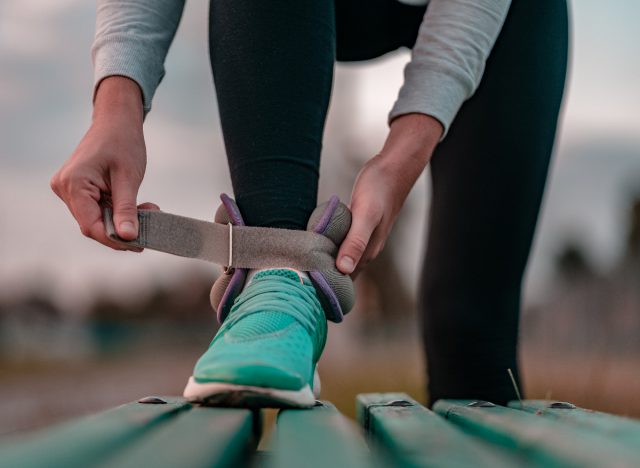This Walking Workout Is Key to Rapid Weight Loss, Expert Says

If you're getting in a high step count each day, kudos to you! It's an excellent way to keep your body active. But if your goal is to burn some serious calories, it's time to kick things up a notch or two. We're ready to do just that! This walking workout is key to rapid weight loss, an expert reveals, so listen up.
Eat This, Not That! reached out to Mike Bohl, MD, MPH, ALM, the Director of Medical Content & Education at Ro and a member of our Medical Expert Board, who gets real. Regardless of how many steps you take or other exercises you perform, beware. If you continue to consume the same amount of calories or possibly more than you've burned, you'll be stuck in neutral. If your goal is to lose weight fast by walking, dieting is a big part of the process. Hitting the pavement can work wonders, but it needs some solid support!
Optimize your walking efforts in the kitchen and on the pavement.

Before you take your steps, it's important to listen to what Dr. Bohl says about eating so you can optimize your walking efforts. "There's been a lot of research into whether a low-fat or low-carb diet is more effective for weight loss. Different studies have had different findings, but—broadly speaking—one isn't substantially better than the other. Instead, the best choice is to follow whatever diet you're most likely to stick to based on your personal preferences." Now let's get out of the kitchen and move on to the pavement.
The total calories you torch by walking will depend on your speed and weight. To give you an idea, you'll typically burn around 100 calories for each mile you walk. Dr. Bohl tells us, "At an average pace, this means you burn about 350 calories per hour of walking. Since you need to burn 3,500 calories to lose one pound, this means you can lose one extra pound every two weeks if you go for an hour walk five times each week." He also stresses, "Walking is a great way to get up out of your chair and get moving, but as a low-impact, low-intensity exercise, it isn't the massive calorie burner that other exercises can be." But we're going to fix that!
We get that taking strides is a simple way to exercise. You don't need access to a gym or fancy equipment, and it's really a piece of cake to step up and challenge yourself. Basically, whatever you do to increase your level of difficulty as you walk can increase your heart rate, torch more calories, and contributes to your weight loss. Make sure you have athletic shoes with good support for your feet, then check out how to step up your walking workout to lose weight.
Alternate your speed.
One way to kick up your walking performance is to alternate your speed along the way. Walk at your typical pace for several minutes, then speed up your steps for several minutes before returning to your regular speed. When you're done, do it again!
Dr. Bohl explains, "You can think of this as a tamped-down high-intensity interval training workout—during your periods of faster walking, your heart rate will increase and you will burn more calories."
A fun thing to do is to make yourself a playlist with slower and faster songs, alternating between the two. Dr. Bohl suggests, "When each new song comes on, try to match your pace to the beat." And we're just getting started!
Switch up your route.
Don't stop with speed; switch up your trail to burn more calories, too. Find a route that has a solid variety of hills to challenge your muscles. Inclines will torch more calories, so onward and upward. The un-level ground is also beneficial, as it activates and boosts your balance muscles.
Add weight to your body.

Your fitness game will be improved even further with another simple method. Add ankle or wrist weights. If you really want to see progress, consider wearing a weighted backpack. Dr. Bohl explains, "Walking with weight on your back is called rucking, and you can do it with a specialized rucking backpack or by using your own backpack and filling it with books."
Take small breaks to add in other calorie burners.
Spice up your walking workout with a calorie burner every 15 minutes or so. For instance, after walking for 15 minutes, do a minute's worth of squats, lunges, or jumping jacks. Then, continue walking, and repeat.
Add more walking into your daily routine.
Walking to drop weight has much to do with the amount of time you dedicate to it. Dr. Bohl suggests, "To that end, try fitting walking into whatever activities you can during the day. For example, if you work from home, consider investing in a walking pad, so you can walk at your desk during meetings. Or, instead of going on a coffee date with a friend, get the coffee to go and go on a walking date."
Although walking seems pretty basic, it's considered a full-body activity. Dr. Bohl points out, "You use your leg muscles (which are the largest muscles in the body), your core muscles (to stabilize your spine and keep your balance), your arm muscles (to swing your arms), and walking also increases your heart rate and your breathing rate (getting your heart to pump more and your diaphragm to move up and down more)."








